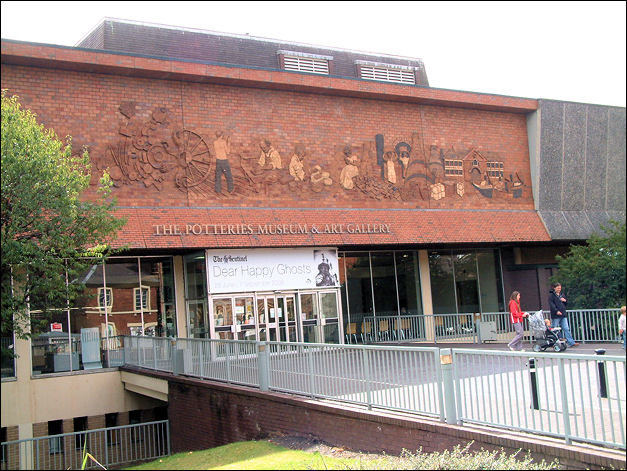![]()
|
|
|
|
|
Stoke-on-Trent - photo of the week |

1947 - the main City Museum and Art Gallery
in Pall Mall, Hanley
| from 1947
City of Stoke-on-Trent Handbook
"Stoke-on-Trent is fortunate in possessing no less than four public museums. These comprise large collections of pottery and porcelain produced in the locality as well as carefully selected examples of the ceramic arts of the countries of the world. Collections of Greek, Chinese, Amerindian and Near Eastern wares are available for study.
The Hanley Museum and Art Gallery, situated in Pall Mall, formerly known as the North Staffordshire Technical and Art Museum, was founded by the North Staffordshire Chamber of Commerce. It now forms the administrative headquarters of the public museums of the city.
The vivarium, to which has been added a seasonal exhibit of living wild flowers, is a new section which attracts a good deal of attention. The Local History Collections are housed in a separate room and contain specimens and documents bearing on the history of the Six Towns.
The Burslem Museum in the Wedgwood Memorial Institute, Queen Street, ranks next in importance. The basis of this museum is the Hulme collection of ceramics, consisting almost entirely of Staffordshire pottery. Because of the associations of Burslem with Wedgwood and the fact that the Institute stands on part of the site of the Brickhouse Works—one of the works of Josiah Wedgwood (1765-73)—this museum specializes in Wedgwood pottery. It also contains a collection of pictures.
The Stoke-upon-Trent Museum is in the Public Library building, in London Road, and contains nineteenth- and twentieth-century pottery and porcelain, and may be said, historically, to commence where the other collections leave off. The exhibits here are not exclusively local, but a large proportion of them represent the Minton and Spode potteries on account of the definite association of these two great nineteenth-century firms with Stoke.
The Tunstall Museum occupies a room in the Library buildings at the Victoria Institute, Station Road. The special feature here is salt-glaze ware, both Staffordshire and foreign, and examples of this have been transferred from the other museums and concentrated here so as to form as representative a series as possible. A second speciality at Tunstall is cream-coloured ware, which developed side by side with salt-glaze, and there is also a special collection of Adams ware given some years ago by Mr. P. W. L. Adams, the present head of the firm.
|

1956 - the new City Museum and Art Gallery
in Broad Street, Hanley
|
from 1957 City of
Stoke-on-Trent Handbook
"As one would expect, the City possesses large and important collections of pottery and porcelain, the earliest of which was acquired as long ago as 1846 by the Stoke-upon-Trent Athenaeum. Later collections formed in Hanley, Burslem and Tunstall were finally absorbed into the permanent collection on the federation of the Six Towns in 1910. Until the outbreak of World War II these collections were exhibited in the museums of the town of origin. On return from dispersal to places of safety during the War, it became obvious that the old museums were no longer able to show these fine collections to advantage and the plans for a new Central Museum and Art Gallery, first mooted in 1929, were taken up with fresh vigour.
Sited on an open space in the centre of Hanley which allows for future extension and a new central Library, the building is easily accessible to the City as a whole. The adjoining car park which provides accommodation for visitors from afar has been tastefully laid out with shrubs and bedding plants. At present the Museum consists of two floors, the lower devoted to ceramics and the upper to painting, sculpture and drawings; on this floor is the George Baskeyfield Music Library where music lovers are able to make use of the collection of 1,500 gramophone records and to consult the library of music scores. The schoolroom, also on the upper floor, is in use from Monday to Friday for organised school visits under the guidance of a qualified resident teacher. Under this scheme, which has the approval of the local Education Authority, children attend at the Museum for courses of study extending over a 12 week period.
As it is not possible to show the Ceramic collection in its entirety a special type of showcase has been devised with undercarriage storage. This arrangement allows of immediate access to reserve material by students and others. The main storage in the basement can be consulted by arrangement with the Curator. Main collections include:— Staffordshire wares of all periods—the slipwares and salt glazed wares are justly famous ; English pottery and porcelain ; Continental porcelain ; German stoneware ; Italian maiolica ; Hispano-Moresque, Turkish, Islamic and Egyptian wares.
The Art Gallery, known as the Russell Gallery in memory of Dr. John Russell, a generous benefactor, contains a small but growing collection of paintings by British artists. Early English water colours are well represented together with some 20th century sculpture and a gathering of paintings by local artists, among whom James Holland, John Currie and Job Nixon are well known. There is a small but choice collection of prints and drawings and a well-nigh complete series of etchings by F. L. Griggs, R.A., given to the City by the family of the late J. T. Webster." |

The enlarged City museum and art
gallery was opened by Prince Charles in 1981
|
related pages Industries of the Potteries - the panel on the façade of the Potteries Museum also see.. Advert of the Week |